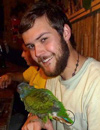

Today's Weather
Lat: 35.29 N
Long: 21.71 E
Air temp: 17°C
Bar. Pressure: 1025.3 mbar
Humidity: 68%
Sea surface temp: 19.7°C, 67.5°F
Winds: WNW; 2.9 knots
Visibility: unlimited

Greek Origin
Word of the Day:
Eureka
from “heureka” meaning “I have found it!”
Mud, Mud, Glorious Mud
December 2, 2011 (posted December 3, 2011)
by Cherie Winner
There was celebration in the Main Lab on R/V Atlantis tonight!
ROV Jason brought back beautiful pushcores from the bathtub ring where the halocline meets the seafloor. At the top of two cores was a grey-green layer that looked different from the mud below it. Right away Dr. Joan Bernhard recognized the layer as a bacterial mat made up of billions of bacteria. These are the first such samples ever brought back from a Mediterranean DHAB.
It’s an exciting find because wherever there are lots of bacteria, there are usually lots of protists, too. Joan says harsh environments such as those that lack oxygen are great places to look for new species of protists and for symbiotic relationships between protists and bacteria that have never been observed before. That’s one of the main reasons she and chief scientist Dr. Ginny Edgcomb wanted to explore the DHABs.
Energized by the successful dive, Joan’s team stayed up late to process and preserve the samples for chemical and microscopic analysis. You can read more about the work that will be done with them in today’s Slideshow.
Jason is going back down for another batch of samples on Saturday. With luck, we will have more to say about the bacterial mats before the cruise is over.
What’s up with SID-ISMS?
You might be wondering what SID-ISMS has been doing the last few days. That’s the brand-new instrument that Ginny and Dr. Craig Taylor and McLane Research Laboratories developed to sample the protists living in the water (as opposed to the sediments). You may remember reading about it in our Daily Update on Nov. 29. Since its successful first deployment, SID-ISMS has had some growing pains. Some parts of the instrument had trouble working at the bottom of the sea, possibly due to the intense pressure, and the high sulfide concentration destroyed the sensor it used to measure salinity. The scientists handling SID-ISMS have worked day and night, with help from colleagues back home at McLane, to get it back on track. They replaced some parts, adjusted others, and fixed a software problem.
Tonight, while the sediment team sliced its cores, Taylor, Edgcomb, and their team sent SID-ISMS on a test dive to 3,500 meters depth in normal seawater. They ran it through the full program the instrument would do on a sampling dive. Many of the adjusted parts worked well enough that the scientists will try to resume their research on the organisms that live in the water of the DHABs. That’s cause for celebration too!
 Colin Morrison: Colin Morrison: Colin Morrison is a senior at the University of Nevada, Reno, studying biology and political science. During the cruise he is working with Dr. Joan Bernhard collecting and processing sediment samples from the DHABs. This is his first experience with oceanography and his first time at sea. Read the interview »
[ Previous update ] [ Next update ]
[Back
to top]
|
